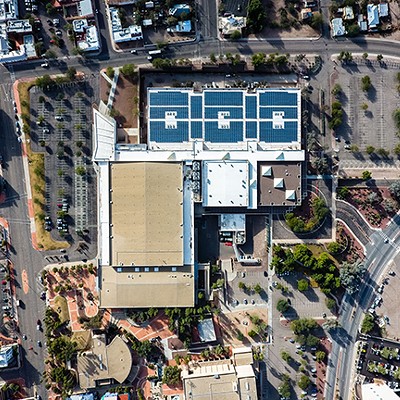"The ordinance is just a joke," says Riley, who has joined his Catalina Foothills neighbors in an uphill battle to save the tributary, which cuts across the last major undeveloped property just northeast of the intersection of River Road and First Avenue. Since last May, D.R. Horton Homes has been pushing ahead with plans for Riverview Estates, a high-density housing project that will put 107 two-story houses on the 50-acre parcel. If the project goes ahead in its current form, a dozen homes will be built along the wash that Riley is surveying--after bulldozers have filled it in and flattened the surrounding area.
Kinda brings a whole new definition to "infill development."
Ken Scoville, a local historian who lives nearby, says the neighbors aren't opposed to development on the parcel, but they'd like to see the developer make a few concessions--such as leaving the wash in its natural state and clustering the homes on the level ground around it. They'd also like the developer to build one-story homes with flat roofs rather the current plans for two-story homes with pitched roofs, which they fear will spoil the view from their homes. And they're concerned that water diverted from this wash will adversely affect the nearby Racetrack Wash, where the developer hopes to build another eight houses, even though that arroyo falls under the protection of the city's Environmental Resource Zone.
"We just want something that's compatible with the neighborhood and the way the foothills have been developed," Scoville says. "It's just a classic situation where a developer wants to get as much as he can and he's got a product that he's used to doing and he doesn't want to bend on that product."
So far, the neighbors' concerns have had little impact on the developer's plans. The property, which is on the edge of the city limits, has long been zoned for high-density development, but the neighbors have been trying to persuade the city's Development Services Department that the project should be limited by regulations protecting hillsides.
No dice, says Ernie Duarte, an assistant director with Development Services, who explains that the city's calculations show the slope on the property isn't severe enough to trigger protection under the ordinance.
Duarte maintains that the city has taken an interest in preserving the wash. "In our last review of the project we have asked the developer's engineer to provide justification as to why that 25-percent slope could not be preserved," he says, adding that officials are reviewing whether D.R. Horton will be able to build another eight houses within the flood plain of the nearby Racetrack Wash.
The neighbors have appealed the decision on the hillside protection issue to the city's Board of Adjustment, arguing that the city's formula is unsound. The board is scheduled to hear the case at its February 27 meeting, but the neighbors are now seeking a delay to a March date so they can outline other elements in their case.
Riley remains dismayed by the way city officials have allowed the development to move forward. "What's the point of having a hillside ordinance if you're able to circumvent it any time you like?" he asks. "The city is not interested in the spirit of that ordinance. They're doing everything they can to let the developer get in there and do whatever he wants."
The project is proving to be quite the political hot potato for Councilmember Kathleen Dunbar, who represents the area.
Last week the Republican, elected to Ward 3 just last November, hosted a meeting in her office between the neighbors, the developer and the city staff. Dunbar barred the Weekly from the meeting, saying, "It was the first time to get people to the table together and people grandstand for the media and we just wanted open dialogue from everybody."
D.R. Horton executive Lou Turner arrived at the meeting with a local political heavyweight in tow: Democrat Stan Abrams, the longtime local developer who most recently played a key role in designing the transportation plan for the city's upcoming half-cent sales-tax election. Abrams' precise role in the development remains unclear; neither he nor Turner returned a phone call requesting comment. But as a former business partner of Mayor Bob Walkup who stumped for the Republican during his 1999 campaign, Abrams wields considerable clout at City Hall.
Dunbar finds some of the neighbors' requests to be "very reasonable," including their desire to see one-story homes and to keep houses out of Racetrack Wash. But she's skeptical of the request to stop the construction of the dozen homes in the wash that D.R. Horton plans to eliminate.
"You can't ask a developer to cut out a quarter of the houses they have planned for development," she says.
Dunbar will referee another meeting between city staff, the neighbors and the developer on February 7. "We'll see what the developer is going to do," she says.
In the meantime, the neighbors are working every political angle they can. They're well aware that Walkup wants to persuade them to be annexed into the city limits and have made a point of telling Tucson officials that their response to that entreaty rests on the outcome of this fight.
Dunbar downplays the impact of the "blade-and-grade" development on the city's annexation efforts.
"They're trying to turn it, with your help, into a test for the city," Dunbar says. "If they weren't getting the media attention, if you weren't highlighting that, it wouldn't be a test because nobody would even know this was happening."

















